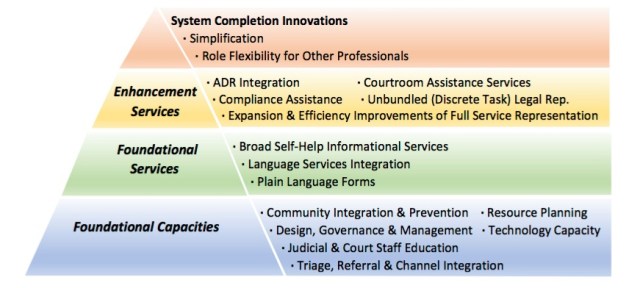The Justice for All Strategic Planning Guidance Materials are now published here.
They will be very helpful for the states that are in the process of putting together the proposals for strategic planning money that are due on October 5, as described in the RFP. (Disclosure: I have been involved in the planning process for this project, including as one of the expert group. Obviously, in this post I speak very much only for myself.)
However, the tools can be used in a wide variety of ways to promote access, and I strongly encourage all to look at them carefully from the point of view their own work. The role of this synthesis of experience is potentially far greater than its use for strategic planning, critical thought that is.
The complete Guidance packet consists of three sections each of which includes a number of resources that will be of broad help to access advocates and planners:
I. An Introduction to the Effort
This section describes the history and goals of the project, and the key suggested components of access and therefore of planning, the importance of the user perspective and the role and makeup of a planning group.
Perhaps most importantly, at least in planning terms, it contains a a detailed Appendix describing the sixteen components for suggested planning:
- Design, Governance & Management
- Resource Planning
- Technology Capacity
- Triage, Referral, & Channel Integration
- Community Integration & Prevention
- Judicial & Court Staff Education
- Broad Self-Help Informational Services
- Plain Language Forms
- Language Services Integration
- Alternative Dispute Resolution Integration
- Compliance Assistance
- Courtroom Assistance Services
- Expansion & Efficiency Improvements of Full Service Representation
- Unbundled (Discrete Task) Legal Assistance
- Simplification
- Role Flexibility For Other Professionals
The component descriptions follow a common format, and, in my opinion, represent the first comprehensive bringing together of all these elements, at least in such a common format.
For each of these sixteen, the Appendix details:
- The rationale and need
- The key elements for the component
- General approaches to building the component
- Additional comments on matters such as problems, prioritization, risks, and current knowledge status.
I believe that these single page descriptions in the Appendix will prove a highly useful tool for stimulating discussion in almost any forum. The reflect perhaps 20 years of experience in almost every state, and can be a foundation for much activity.
II. Inventory Assessment Guide
The inventory assessment guide has been drafted to assist state planners take the measure of the state of access to justice in their state. This is intended both to help them make the wisest possible choices in their ultimate plan and to lay the groundwork for the measurement of achievable outcomes envisioned in the CCJ/COSCA Resolution.
The overall approach recommended is to follow state customized versions of tools designed to measure the state of play for each of the components, grounded in the elements and descriptions in the Appendix to the Introduction.
The draft assessments for each of the components (which are included in the Guide) suggest standard questions about status, penetration,sufficiency, and scaleability of current deployment. The answer grid allows for choices all the way from “no” to sustainable, and also for notes. There is space for additional component notes on each assessment. My thought it that many states may find it useful to use these note options for begin the analysis of differences by case area, which will have major strategic implications. The assessment questions incorporate the individualized key elements of each components.
III. Strategic Planning Guide
The Planning Guide is the key document that brings together all the data and knowledge gathered about the specific state environment with the planning experience integrated from throughout the country.
Firstly, it discusses the development of the planning team, including the importance of including a broader than usual range of stakeholders. Then, it discusses the different focuses that planning might take, including case type or regional, for example.
With respect to key issue of prioritization, the Guide offers a cluster approach, as shown in the chart below.

As a general matter, work starts at the bottom, and moves up, and many of the higher ones require components in lower parts of the pyramid to be at least partially completed before they can be moved forward effectively.
After discussing reasons that such prioritization might be modified, the document offers an action plan checklist, suggests how to integrate the component assessment into a general assessment, and provides a very general component plan template.
All in all, this is a powerful toolbox.
I urge all involved in the access movement to study it carefully for ways it can help them in their work. I urge all to share it, talk about it, and pull from it. It is about far more than the RFP, or even strategic planning. It is a major distillation of knowledge.
I hope in future blogs to be able to contribute to thinking about ways that this can all be as much help as possible.


Pingback: Corrected Version With Link — Integrating the ABA Futures Report and the Justice For All Components | Richard Zorza's Access to Justice Blog